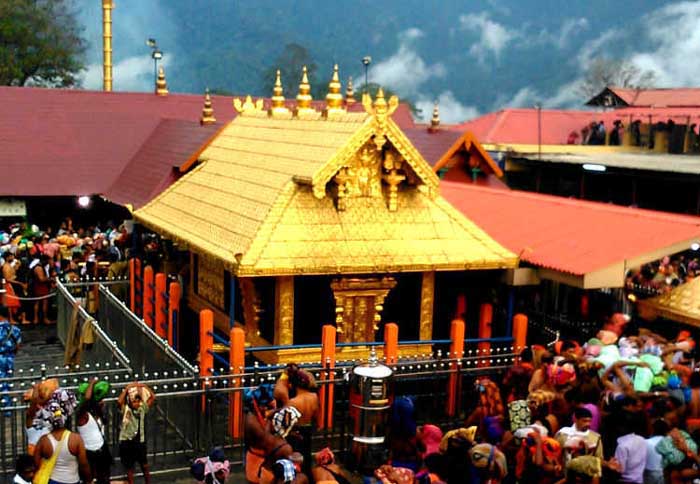Sri Ayyappa Temple Sabarimala

Information of Sri Ayyappa Temple, Sabarimala, Pathanamthitta, Kerala
Sri Ayyappa Temple at Sabarimala or Shabari Hills is a famous Hindu pilgrimage shrine of the South India. It is a beautiful temple built on the hilltop of the great Western Ghats of the Southern Malabar region. Majority of the pilgrims are from the Andhra and from Tamil Nadu States, the Kerala and Karnataka devotees do visit here along with these devotees. This temple is open for two months only and pilgrimage starts from November and end on January 14th of every year. It is a hard temple to reach its hilltop and once has to trek these hills with dense forest surroundings. Many non Kerala peoples come here as a temple tour since they don't have a place like the Gods own county in their state. This is one of the cool and pleasant pilgrimages along with Mother Nature, since on can't forget those lovely lush green fields, pasture lands, the Western Ghats valley with rivers and forest. Here one can feel the essence of god in the creation and can say they are in the Gods own country along with monsoon rain on the Western Ghats. It is located on the Shabari Hills of Pathanamthita District of Kerala State in India.
Sri Ayyappa Temple Religious Significance
Lord Ayyappa is a young male god and he is known as Manikandan, Kanni Swami, Shaberehwaran and Iyappa Swamy. Sri Ayyappa is worshiped mainly by the men's. Here adult women's are not allowed to visit this temple since the Lord is a celibate. But female children's below 10 years of age and women's above 50 years of age is permitted to take Shabari mala pilgrimage. This temple is mostly popular among the South Indian Hindu peoples. Here any one decides to take pilgrimage must take a 41 days abstain from non vegetarian foods. Bathing twice a day and pray nearby Ayyappa temples and come to the main temple with pure devotion. Its devotees must avoid tobacco and alcohol too. Throughout the trek journey on the hills the devotees chant Ayyappa mantras. It is believed that while chanting these mantras the pain of rough mountain terrain and forest weeds doesn't make pain on their bare feet. The black color clothing is worn by its devotees but now the Tamil Nadu peoples have introduced the Blue and saffron color clothing according to their belief. Many devotees do reach here to witness the Makara Jyothi which is like a celestial event which is seen on the opposite hills of this temple. Here devotees carry a bundle of ritual material on their head still they reach the main temple. This bundle carries coconut, rice, bananas and flowers. The coconuts are filled with ghee and this is thrown in the Agni khund of this temple which starts burning since the temple is open and close by a two months time.
Sri Ayyappa Temple Mythology & History
There are many myths behind the origin of Shabari Ayyappa temple. Few Hindus believe that it was the creation of Lord Parashuram, since the entire Kerala was created by him by throwing his axe. There is also an aristocratic tale behind this temple. It is believed that the Pandalam king of the Malabar region made the way to Shabrimala pilgrimage. It was said that the king doesn't have a son and one day he got Ayyappa on the river banks of this Ghats. This was disliked by many in his family members and by his ministers. Initially the adopted son returned to these forest areas to meditate and become a saint. But he was no more seen since then. But Ayyappa ordered the King to build a temple for him on this hilltop and asked everyone to visit here if they want to see him. Since then he was believed as the son of god.
Sri Ayyappa Temple Architectural Significance
This is an ancient temple and the origin and creator of this temple is unknown till now. But in 1821 AD the ancient temple was rebuilt. In 1950 this was destroyed in a fire incident. The present temple is seen with lot of modern amenities for the pilgrims. It is truly a Kerala architecture where the 40% of the building structure is made of granite or the laterite block and 60% are erected with wooden works. The main temple consists of the idol of lord Iyappa in a seated position. There are 18 gold plated steps to reach these main temple complexes. Nearby the temple an Aghni Kund is built for the devotees to throw the ritual materials to burn here. There is a huge flag pole in front of this temple. On the way there are few temples and a mosque related with Iyappa legends.
Festivals at Sri Ayyappa Temple
There is no specific temple festival here and so the temple is usually closed most of the time. The temple opens for 2 months on a yearly basis and this is a festival season for the South Indian Hindus or the believers in Ayyappa. The opening and closing are the most important days of this temple. It is always filled with lakhs of devotees throughout this Shabari pilgrim seasons. The Makara Jyothi is also an important day to witness the holy event of this divine fire seen on the opposite hills which sees huge gathering of devotees and visitors to the temple.
- Andhra Pradesh Temples
- Assam Temples
- Bihar Temples
- New Delhi Temples
- Goa Temples
- Gujarat Temples
- Jammu and Kashmir Temples
- Karnataka Temples
- Kerala Temples
- Madhya Pradesh Temples
- Maharashtra Temples
- Odisha Temples
- Punjab Temples
- Rajasthan Temples
- Sikkim Temples
- Tamil Nadu Temples
- Telangana Temples
- Uttar Pradesh Temples
- Uttarakhand Temples
- West Bengal Temples